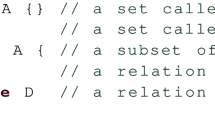Abstract
The Alloy modeling language has a mathematically rigorous denotational semantics based on relational algebra. Alloy specifications often represent operations on a state, suggesting a transition-system semantics. Because Alloy does not intrinsically provide a notion of state, however, this interpretation is only implicit in the relational-algebra semantics underlying the Alloy Analyzer.
In this paper we demonstrate the subtlety of representing state in Alloy specifications. We formalize a natural notion of transition semantics for state-based specifications and show examples of specifications in this class for which analysis based on relational algebra can induce false confidence in designs. We characterize the class of facts that guarantees that Alloy’s analysis is sound for state-transition systems, and offer a sufficient syntactic condition for membership in this class. We offer some practical evaluation of the utility of this syntactic discipline and show how it provides a foundation for program synthesis from Alloy.
Access this chapter
Tax calculation will be finalised at checkout
Purchases are for personal use only
Preview
Unable to display preview. Download preview PDF.
Similar content being viewed by others
References
Jackson, D.: Software Abstractions. MIT Press, Cambridge (2006)
Abrial, J.R.: The B-Book: Assigning Programs to Meanings. Cambridge University Press, Cambridge (1996)
Spivey, J.M.: The Z Notation: A Reference Manual, 2nd edn. Prentice Hall, Englewood Cliffs (1992)
Krishnamurthi, S., Dougherty, D.J., Fisler, K., Yoo, D.: Alchemy: Transmuting base alloy specifications into implementations. In: ACM SIGSOFT International Symposium on the Foundations of Software Engineering (2008)
Dougherty, D.J.: An improved algorithm for generating database transactions from relational algebra specifications. In: International Workshop on Rule-Based Programming (2009)
Jackson, D.: Alloy: a lightweight object modelling notation. ACM Transactions on Software Engineering and Methodology 11(2), 256–290 (2002)
Edwards, J., Jackson, D., Torlak, E.: A type system for object models. In: ACM SIGSOFT International Symposium on the Foundations of Software Engineering (2004)
Krishnamurthi, S., Hopkins, P.W., McCarthy, J.A., Graunke, P.T., Pettyjohn, G., Felleisen, M.: Implementation and use of the PLT Scheme web server. Higher-Order and Symbolic Computation 20(4), 431–460 (2007)
Plotkin, G.D.: LCF considered as a programming language. Theoretical Computer Science, 223–255 (1977)
Frias, M.F., López Pombo, C.G., Galeotti, J.P., Aguirre, N.M.: Efficient analysis of DynAlloy specifications. ACM Transactions on Software Engineering and Methodology 17(1) (December 2007)
Massoni, T., Gheyi, R., Borba, P.: A framework for establishing formal conformance between object models and object-oriented programs. Electronic Notes in Theoretical Computer Science 195, 189–209 (2008)
Bates, J.L., Constable, R.L.: Proofs as programs. ACM Transactions on Programming Languages and Systems 7(1), 113–136 (1985)
The Coq development team: The Coq proof assistant reference manual. LogiCal Project, Version 8.0 (2004)
Green, C.C.: Application of theorem proving to problem solving. In: International Joint Conference on Artificial Intelligence (1969)
Waldinger, R.J., Lee, R.C.T.: PROW: A step toward automatic program writing. In: International Joint Conference on Artificial Intelligence (1969)
Rich, C., Waters, R.C.: Automatic programming: Myths and prospects. IEEE Computer 21(8), 40–51 (1988)
Author information
Authors and Affiliations
Editor information
Editors and Affiliations
Rights and permissions
Copyright information
© 2009 Springer-Verlag Berlin Heidelberg
About this paper
Cite this paper
Giannakopoulos, T., Dougherty, D.J., Fisler, K., Krishnamurthi, S. (2009). Towards an Operational Semantics for Alloy. In: Cavalcanti, A., Dams, D.R. (eds) FM 2009: Formal Methods. FM 2009. Lecture Notes in Computer Science, vol 5850. Springer, Berlin, Heidelberg. https://doi.org/10.1007/978-3-642-05089-3_31
Download citation
DOI: https://doi.org/10.1007/978-3-642-05089-3_31
Publisher Name: Springer, Berlin, Heidelberg
Print ISBN: 978-3-642-05088-6
Online ISBN: 978-3-642-05089-3
eBook Packages: Computer ScienceComputer Science (R0)




